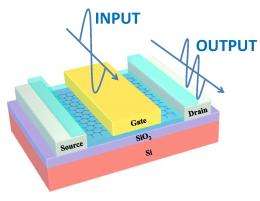May 11, 2010 feature
Graphene transistor could advance nanodevices

(PhysOrg.com) -- For years, scientists and researchers have been looking into the properties of carbon nanotubes and graphene for use in nanoelectronics. "There is no real mass application of devices based on graphene and carbon nanotubes," Zhenxing Wang tells PhysOrg.com. "This is really an opportunity for them to show their capabilities."
Wang is part of a group at the Key Laboratory for the Physics and Chemistry of Nanodevices at Peking University in Beijing. Along with Zhiyong Zhang, Huilong Xu, Li Ding, Sheng Wang, and Lian-Mao Peng, Wang tested a top-gate graphene field-effect transistor based frequency doubler in order to gauge its performance. They were able to show that a graphene based frequency doubler can provide more than 90% converting efficiency, while the corresponding value is not larger than 30% for conventional frequency doubler. Their work is published in Applied Physics Letters: “A high-performance top-gate graphene field-effect transistor based frequency doubler.”
“Our work focused on raising the gain and frequency response of the frequency doubler by utilizing top-gate geometry on the device,” Wang explains. “Only with a top-gate can people fabricate high-performance devices and integral circuits. This work paves the way to mass application of graphene transistors in the near future.”
Graphene is desirable as a transistor material due to its high performance. Wang points out that IBM recently showed that graphene transistor can operate up to 100 GHz, and the group at Peking University believes that the material may even still operate well in the THz regime. “This is very exciting,” Wang says, “because a frequency doubler with high frequency and high efficiency can be very expensive. Our device is cheaper - only consisted by one transistor - but with much higher efficiency.”
In Beijing, the group fabricated the device with standard lithography, layering the graphene on a silicon wafer, smaller than 1mm x 1mm. In order to test the performance, Wang and his colleagues used a digital oscilloscope. They also used a recent test method, developed at Peking University, to measure performance of the graphene doubler. “We developed a new test method with a spectrum analyzer, which can obtain direct frequency information and sense a much smaller signal that can’t be obtained by oscilloscope.”
Moving forward, this work could lead to the development of graphene transistors for nanoelectronics. “In principle, this kind of device can be realized on a wafer scale, based on current lithography technology and wafer-scale graphene growth. Mass production can be realized once the graphene growth technology becomes mature,” Wang explains. “We are looking forward to the mass production of a graphene based frequency doubler with frequency response up to 100 GHz, gain larger than 1/10, and with low cost and low power consumption.”
This future, though, could still be five to 10 years away, and Wang is not overly concerned about the mass production end of it just yet. “I’m now focusing on improving the performance of the device in demonstration in order to show its potential. Possible optimization can be made through such means as replacing the substrate with insulating materials to reduce the parasitic capacitance.” At some point, though, graphene transistors could help advance the development of nanoscale electronics, and the work done by the scientists at Peking University are providing a step in that direction.
More information: Zhenxing Wang, et. al., “A high-performance top-gate graphene field-effect transistor based frequency doubler,” Applied Physics Letters (2010). Available online: link.aip.org/link/APPLAB/v96/i17/p173104/s1
Copyright 2010 PhysOrg.com.
All rights reserved. This material may not be published, broadcast, rewritten or redistributed in whole or part without the express written permission of PhysOrg.com.




















